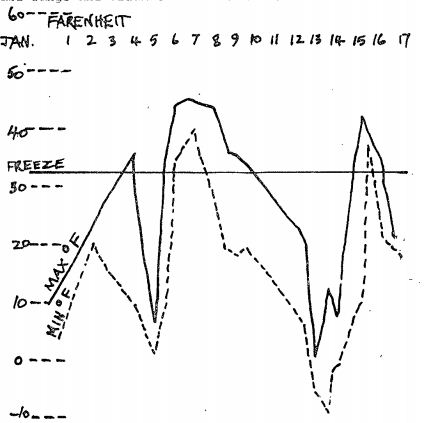Weather In Glenmoriston
From Moriston Matters, Issue 11, February 1979.
WEATHER REPORT.
Just to break the ice as it were! - the weather, always being a major British talking point, has given us all rather more to think about than usual. This year's weather has been exceptional to say the least and the records here, up the Glen, make some very interesting comparisons possible. The weather centre in Glasgow gets occasional reports from Glenmoriston when conditions seem exceptional, so we are on the weather maps despite the apparent ignorance of local conditions shown by the national forecasts quite frequently. This shortcoming as far as forecasting is concerned is due to our unique geographical position and physical features which often cause complete contradictions of the general trend. For instance, sometimes when heavy moisture-laden westerly winds are forecast to give heavy rain in our area, the Glen and often the village are drier and finer than the Western Highlands in general. This is because there is a natural low pass all the way to the west coast at Kyle, through Loch Alsh, Loch Duich, Glen Shiel and Loch Cluanie, then down Glenmoriston. The air does not rise so much as on either side where the Kintail range and Cluanie ridge push it to over 4,000 feet, and therefore we get, in an admittedly narrow track, less than Glen Garry or Glen Affric. This track is so well defined that it is often possible to see it pouring down at Inverwick while the Glen road is quite dry. Daniel might well be wondering, who this twit is, telling him how dry we are!, but there is a reason , and it is that a big eddy is caused during westerlies over Cluanie, by Sgurr an Lochain and Aonach air Crith at 3282 and 3342 feet respectively, swirling the air-stream up and over 5,000 feet, then it just has to drop the lot all over that area!
Now to 1979 and temperatures which have caused a great deal of worry, damage and concern to everyone in the community, from frozen domestic water supplies to frostbitten stock. The GRAPH illustrates the record so far at Dundreggan (in mid-January).

The main peaks were on the nights of 1st January and 5th at 0°F (32 degrees of frost) and the nights of 12th January and 13th giving -9°F and -2°F respectively, which is 41 degrees of frost. This is the lowest notified and recorded temperature in this area (Western Highlands) this century and was the third lowest temperature recorded in Britain on the night of Friday 12th. The others were 1°F less in Lanarkshire - the lower one 2°F less, that is -11°F, in Carnwath, Lanarkshire again. Reasons: extremely low temperature air-stream from North coupled with clear skies all night providing no insulating blanket of cloud and a constant build-up of these conditions for almost a week. Ironically the weather station at the North Pole had daytime and night temperatures some 5 -10°F warmer than we had between the 10th and 14th of January, although as a matter of comparison, the lowest temperature ever recorded at the North Pole is -89.9 F in Siberia (that is 119 F of frost), and in the world, at the South Pole, a record low of -126.4°F (more than 158 F of frost) has been recorded.
Well, until the ice age really gets to grips with us and new records are set we should be past the worst for this season in terms of frost.
M.A.T
On the night of January 12th - 13th Pat recorded 16°C of frost at the Filling Station - the lowest recording in the ten years since he began keeping records and the temperature on Saturday, 13th did not rise above -9 C all day.